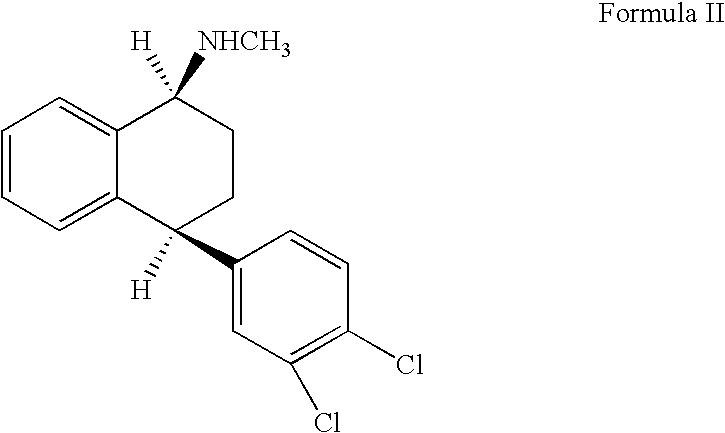Process for converting trans-sertraline to cis-sertraline
a technology of trans-sertraline and cis-sertraline, which is applied in the field of process for converting trans-sertraline to cis-sertraline, can solve the problems of increasing the cost of production, difficult to recover solvents, and difficult to handl
- Summary
- Abstract
- Description
- Claims
- Application Information
AI Technical Summary
Problems solved by technology
Method used
Image
Examples
example 1
Preparation of Pure Racemic Cis-N-Methyl-4-(3,4-Dichlorophenyl)-1,2,3,4-Tetrahydro-1-Napthalenamine Hydrochloride of Formula (I)
[0023] 200 g (0.654 moles) of mixture of racemic trans-isomeric 4-(3,4-dichlorophenyl)-1,2,3,4-tetrahydro-N-methyl-1-napthalenamine, 1000 ml of pyridine, 180 g (4.92 moles) of potassium hydroxide and 76 ml of water were charged to a clean and dry round bottom flask. The resultant reaction mixture was heated to about 115-120° C. for about 20-25 hours. Solvent from the reaction suspension was distilled at about 80° C. under reduced pressure and the resulting residue was dissolved in 1000 ml of toluene. Resultant reaction solution was washed with (5×668 ml) water and the solvent was distilled off at about 80° C. under reduced pressure, resulting in a residual oil containing a 1:1 mixture of racemic cis- and trans-isomeric 4-(3,4-dichlorophenyl)-1,2,3,4-tetrahydro-N-methyl-1-napthalenamine. The obtained residual oil was dissolved in methanol (1000 ml) and sub...
example 2
Alternative Preparation of Pure Racemic Cis-N-Methyl-4-(3,4-Dichlorophenyl)-1,2,3,4-Tetrahydro-1-Napthalenamine Hydrochloride of Formula (I)
[0024] A mixture of racemic trans-isomeric 4-(3,4-dichlorophenyl)-1,2,3,4-tetrahydro-N-methyl-1-napthalenamine 20.0 g (0.0654 moles), 100 ml of pyridine, 13 g (0.325 moles) of sodium hydroxide and 7.6 ml of water were charged to a clean and dry round bottom flask. The contents were heated to 115-120° C. for about 24 hours. The solvent from the reaction mass was distilled under reduced pressure and the resulting residue was dissolved in 100 ml of toluene. The reaction solution was washed with water (5×66.8 ml). Organic solvent was distilled under reduced pressure, which resulted in a residual oil containing a 1:1 mixture of racemic cis- and trans-isomeric 4-(3,4-dichlorophenyl)-1,2,3,4-tetrahydro-N-methyl-1-napthalenamine. The residual oil was dissolved in methanol (100 ml) and subsequently the resultant solution was treated with aqueous hydroc...
example 3
Alternative Preparation of Pure Racemic Cis-N-Methyl-4-(3,4-Dichlorophenyl)-1,2,3,4-Tetrahydro-1-Napthalenamine Hydrochloride of Formula (I)
[0025] A mixture of racemic trans-isomeric 4-(3,4-dichlorophenyl)-1,2,3,4-tetrahydro-N-methyl-1-napthalenamine 20 g (0.0654 moles), 100 ml of pyridine, 6.5 g (0.162 moles) of potassium hydroxide, 9 g (0.161 moles) of sodium hydroxide, and 7.6 ml of water were charged to a clean and dry round bottom flask. The contents were heated to about 115-120° C. for about 20-25 hours. The solvent from the reaction mass was distilled completely at about 80° C. under reduced pressure and the resulting residue was dissolved in 100 ml of toluene. The resultant reaction solution was washed with water (5×66.8 ml). The organic solvent was distilled under reduced pressure, which resulted in a residual oil containing a 1:1 mixture of racemic cis- and trans-isomeric 4-(3,4-dichlorophenyl)-1,2,3,4-tetrahydro-N-methyl-1-napthalenamine. The residual oil was dissolved ...
PUM
| Property | Measurement | Unit |
|---|---|---|
| temperature | aaaaa | aaaaa |
| temperature | aaaaa | aaaaa |
| temperature | aaaaa | aaaaa |
Abstract
Description
Claims
Application Information
 Login to View More
Login to View More - R&D
- Intellectual Property
- Life Sciences
- Materials
- Tech Scout
- Unparalleled Data Quality
- Higher Quality Content
- 60% Fewer Hallucinations
Browse by: Latest US Patents, China's latest patents, Technical Efficacy Thesaurus, Application Domain, Technology Topic, Popular Technical Reports.
© 2025 PatSnap. All rights reserved.Legal|Privacy policy|Modern Slavery Act Transparency Statement|Sitemap|About US| Contact US: help@patsnap.com



